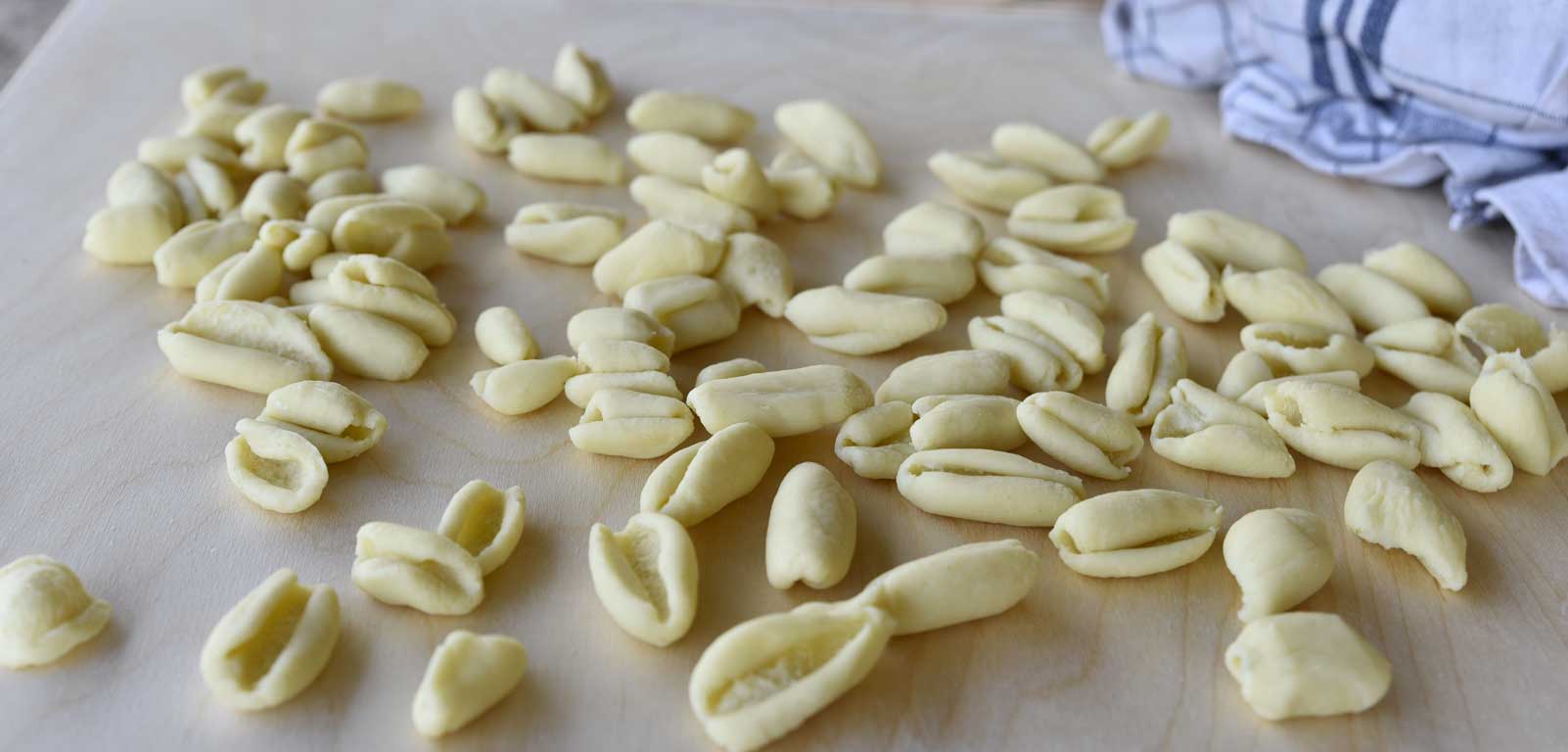Do you know everything about Italian gnocchi? From gnocchi history and authentic recipes to frequently asked questions about cooking, storing, and even pronouncing gnocchi, you’ll find it all in this ultimate guide.
What is gnocchi?
First, if you’re wondering how to pronounce gnocchi, it’s like this: “NYO-kee”.
The g+n sounds similar to ñ in Spanish. In Italian, c+h makes a hard ‘k’ sound.
The word gnocchi comes from the word “gnocca,” or knuckle, and refers to the small and soft, dumpling-like ball shape of this pasta. Dumpling is a great description for gnocchi.
Gnocchi is a popular type of handmade Italian pasta that has a very ancient origin and is prepared in different ways, with different ingredients throughout the country.
In the XVI century gnocchi made with potatoes became very popular, after the starchy tubers were imported to Europe by Christopher Columbus. But not all gnocchi is made with potatoes!
These pillow-like balls of dough are made from different bases, so the name refers specifically to the shape. Gnocchi can be made with potato, squash, ricotta cheese, other vegetables or just flour.
Once formed into a small dumpling, the gnocchi can then be shaped and textured using special tools, or not. Finally, after gnocchi is cooked, it’s usually finished in a sauce or sauté.

This authentic Italian pasta is beloved for its light, pillowy texture that goes perfectly with a variety of sauces and flavor. It’s an incredible comfort food that can easily be made at home; it takes a few minutes to cook and the little pillows will also tell you when they are ready: they float to the surface of your boiling water!
What is an Authentic Italian Gnocchi Recipe?
When thinking of gnocchi, in Italy we speak of a universe of recipes. Most of them are regional, a good number belong to grandmothers, and some others are strictly secret.
But if we want to dig into the tradition and popularity, I would say that in Italy, two classic recipes are Gnocchi alla Sorrentina and Gnudi.
Both recipes are specific to an Italian region: the first one comes from Sorrento on the Amalfi coast, where usually potato gnocchi are oven baked with tomato sauce and mozzarella until bubbly and oozing. The Gnudi, or spinach and ricotta gnocchi, is a typical recipe from Tuscany, usually served with a simple tomato sauce or with butter and sage.
In fancy restaurants, sometimes these are served with very special aged parmesan cheese like pecorino or with a slice of lard that melts in contact with the hot gnocchi.
Access my flour gnocchi recipe and shopping list
when you sign up for my free gnocchi class:
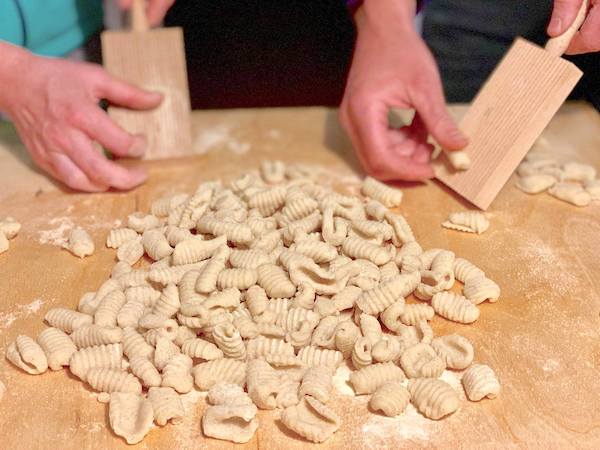


Gnocchi di Semolino
When speaking of recipes hard to find in restaurants and still homemade in Italian households, you can’t omit Gnocchi di Semolino. It’s one of the easiest recipes for gnocchi, just made with semolina, milk, eggs and butter.
Once the dough is ready, gnocchi are shaped and then baked with a lot of cheese, butter and sage. Skipping the step of boiling gnocchi, it’s a great recipe to prepare ahead of time and eat later.
It’s one of my family’s favorites and made since when i was a child for special occasion.
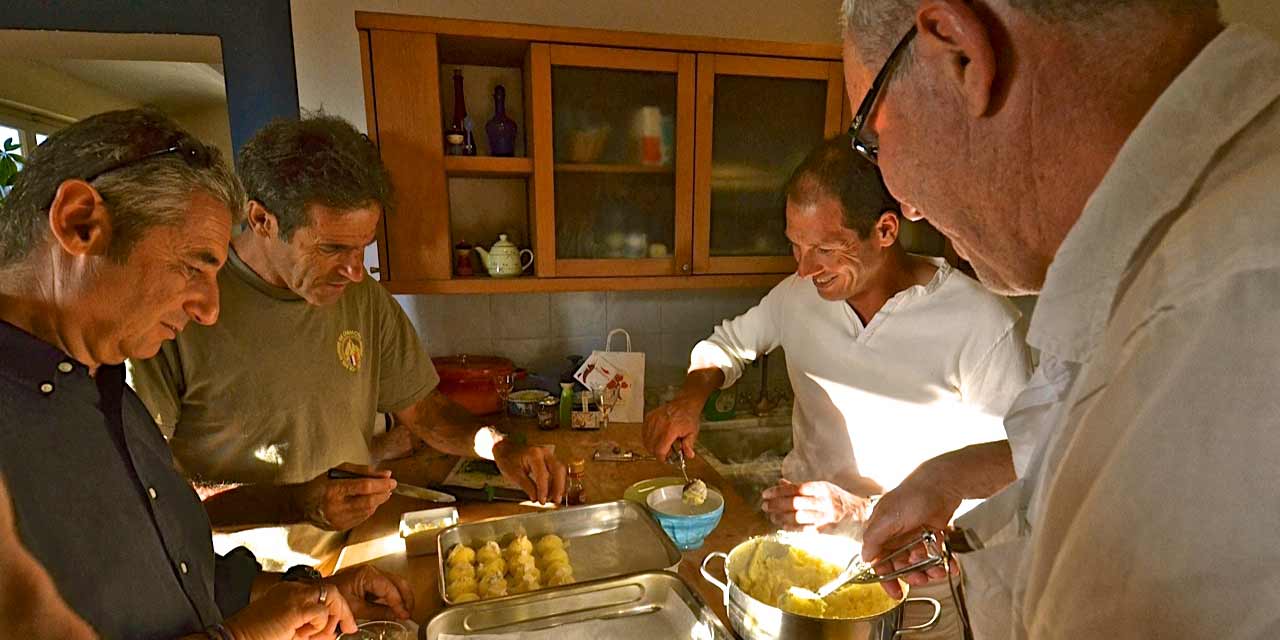
What is Traditional Gnocchi Made From?
Many believe that gnocchi started when potatoes first arrived in Europe. Potatoes arrived in the 14th century following Columbus’s expeditions. But the preparation of dumplings is actually very ancient and made all over the world.
Italians have traditionally made gnocchi with the simplest ingredients: stale bread, different types of flour, different vegetables.
Again, the word “gnocchi” simply refers to the shape of pasta. Gnocchi are just small pieces of dough boiled in water.
Gnocchi recipes often include potato or squash. In modern times, the use of gluten free flours is also an option.
How to Make and Prepare Gnocchi
There are lots of different ways to make and prepare gnocchi but it always starts with a choice of the base flour, vegetables or starch ingredient to use.
What’s important to note is that the texture of the gnocchi changes depending on the type of base you use. For this article, we will specifically talk about using the most common methods to make gnocchi, using potatoes and/or flour.
Regardless of the method, the ultimate goal should be to create light, pillowy gnocchi that are easy to bite into. The gnocchi should not be dense, gummy, or chewy.
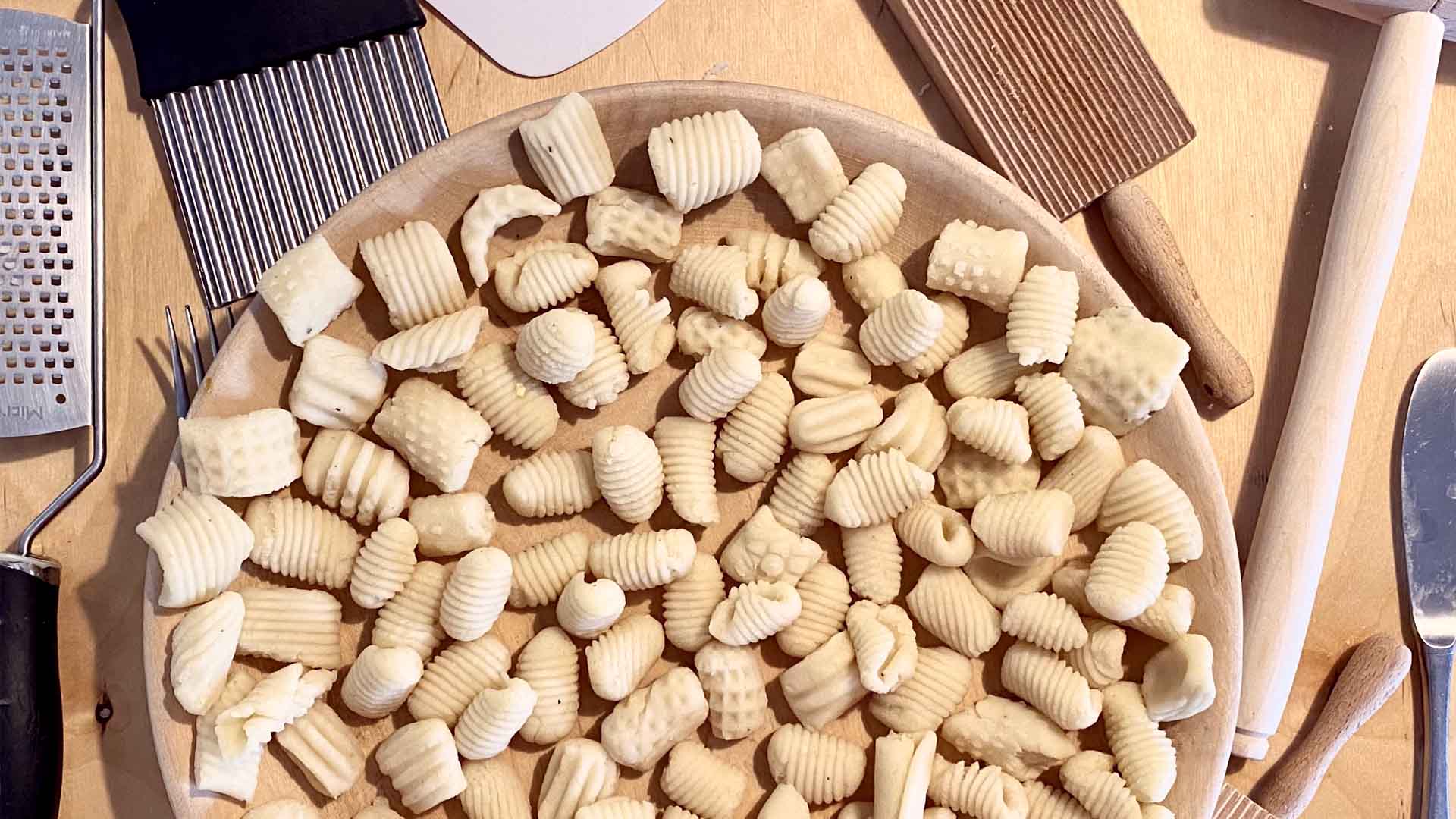
Homemade Potato Gnocchi Recipe
Most people know about this traditional method to make gnocchi with mashed potatoes. While it can be difficult for people to do on their own for the first time, with practice and experience, making gnocchi with potatoes can be easy if you know some tricks.
First, it’s essential to have the right type of potatoes. They should not be new potatoes, as they have too much water content and not enough starch. New potatoes would require a greater amount of flour to hold the gnocchi together, resulting in hard and gummy gnocchi.
Using the mashed potatoes and finding the balance of the moisture to flour content can be tricky too, and takes experience and skill.
But don’t be scared! With practice and over time, you’ll be able to master this technique.
Pro Tips for Potato Gnocchi
• Choose the right kind of potatoes – we suggest russet potatoes or ones similar to it as it has a high starch content and don’t absorb too much water. Potatoes should be the same that are used to make french fries.
• Always cook/boil potatoes with the skin on and start in cold, salted water – the potatoes will cook more evenly. If you start cooking potatoes in boiling water, they will overcook on the outside and remain hard in the middle.
• Cook the potatoes just right – cooking the potatoes just right is important to have not too much moisture in the gnocchi dough.
• Getting the right flour/moisture balance is key -. To make sure your potato gnocchi dough has enough flour, make 4-5 gnocchi and cook them in a small pot of boiling water. If they hold together, your gnocchi dough is done.
• Don’t over- knead and don’t use a food processor/blender to mash cooked potatoes – Gnocchi dough requires a light and gentle kneading to have that light, pillow-like texture. Kneading too much or mashing up potatoes with a food processor creates a gummy, chewly like texture – not great for gnocchi.
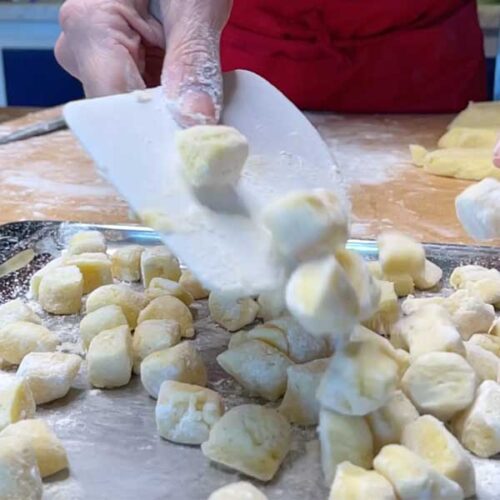
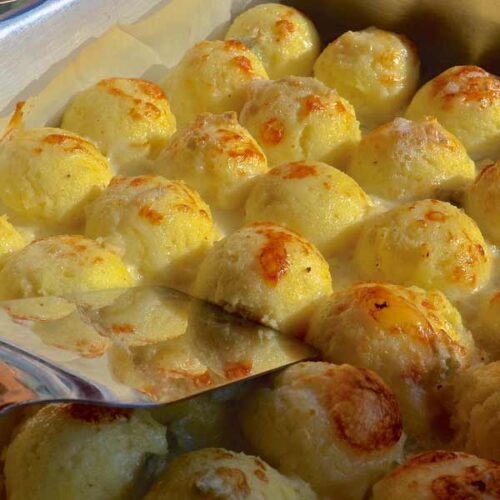
Using Flour to Make a Gnocchi Recipe Without Potatoes
This method is not as well known as using potatoes, but is a much easier method, especially for beginners. I like to teach my authentic flour gnocchi recipe in introductory classes for this reason.
When combined with water and kneaded, flour forms gluten strands that hold the dough together much easier than cooked potatoes. But as with the potato method, it’s important not to over-knead the dough in order to keep the gnocchi light and fluffy.
First, water is boiled and combined with butter, parmesan cheese, and pinches salt, and pepper.
When the ingredients have melted together and the water starts boiling, the flour is added all at once, the heat is turned off, and everything is stirred together until well combined.
On a work surface, the dough is light kneaded until it becomes homogeneous and ready to work with.
Pro Tips for Flour Gnocchi
• Why 00 is the best flour to make gnocchi – This soft flour has less chew than hard flour like All-Purpose or Bread flour. In Italy, we call it a “weak” flour. It creates less gluten bonds but still has enough for the dough to hold together.
• Don’t over-knead the dough – Remember, you’re going for a light and fluffy texture and this is only achieved by lightly working the dough.
Shaping the Gnocchi: How To
This is the process that gives this beloved pasta its namesake.
Regardless of the method you used to create your dough (flour or potato or otherwise), you should end up with a homogeneous dough ball.
It should be just barely holding its shape, a good sign that the gnocchi dough is not overworked.
Divide this larger ball into smaller parts. Start with one of these smaller segments and roll it into a long rope. For my classic flour gnocchi, I make the ropes the thickness of my index finger.
Cutting the gnocchi dough into dumplings
Cut the rope into tiny dumpling pillows and voila, you’ve just made gnocchi!
Repeat the process with the remaining dough. Be sure to keep the size of each gnocchi consistent.
But wait, there’s more! You can take your gnocchi to the next level by shaping and adding texture with various tools.
Regardless of the tool you end up choosing to shape the gnocchi, the goal remains the same: create a small cavity on one side and add texture to the other side. By doing this, whatever sauce you use will become nicely trapped in these cavities and textures.
Shaping your gnocchi with a gnocchi board
The most common, traditional method to shape gnocchi is with a gnocchi board. These inexpensive wooden boards have a grooved texture.
One by one, you’ll roll the small pillows against the board with the pressure of your thumb. As it rolls across your thumb and the board, a cavity should result inside with texture from the board’s groove on the outside of each gnocchi.
You can be creative about the tool you use to shape your gnocchi. Anything with a textured side will work.
You can use cheese grater, a textured meat tenderizer, bamboo sushi roller, the back of a fork, and even a seashell will do. You can even find custom, artistic gnocchi boards on sites like Etsy and Instagram (links here).

Cook Gnocchi in salted boiling water
Whether you’ve made your gnocchi fresh, or you’ve stored it raw in the fridge or freezer, the next step is to boil the gnocchi.
Bring a large pot of water to boil.
Once the water starts boiling, add a couple of handfuls of coarse sea salt (or less if you’re using fine sea salt).
Do not skip this crucial step! Cooking gnocchi in salted water is vital and a sin to Italians if omitted. As we often say, “if water is bland, pasta will also be bland.”
Once your water has been salted and brought back to a rolling boil, add all of your gnocchi. They will sink to the bottom and need to cook for a couple of minutes.
As gnocchi cook, they will start floating to the top of the water.
Make sure to taste test a couple at this point. If the dough is not yet cooked all the way through, the gnocchi won’t have a consistent texture inside.
Once cooked through, the gnocchi are ready to be taken out of their bath. Remember, cooking times will vary for everyone so please test and make your own determination.
Using a small strainer, transfer the gnocchi into a sauce pan with the sauce of your choice pre-heated.
What is the Best Sauce for Gnocchi?
One of the best things about gnocchi is that they go well with a variety of sauces.
A very popular way to serve gnocchi is with tomato, basil and mozzarella. This simple trio is at the base of the famous Gnocchi alla Sorrentina, in the Sorrento style, where the gnocchi are baked and the melted mozzarella binds the sauce and the gnocchi with cheese strings.
Here are some other gnocchi sauce variations that we love:
• Gnocchi with fresh pesto
• Gnocchi with sage, melted butter, and parmesan
• Gnocchi with pancetta and peas
• Gnocchi with prosciutto and walnuts
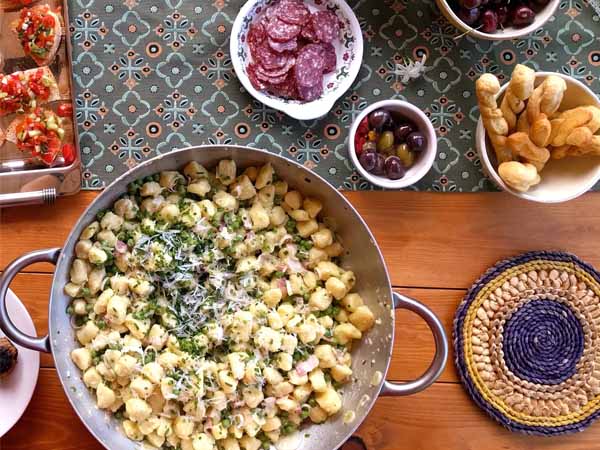
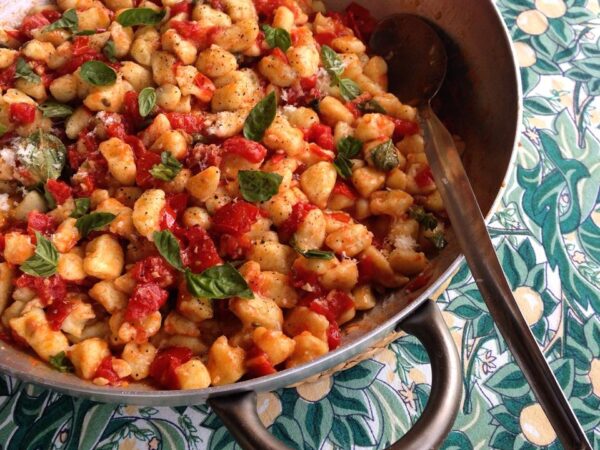
What is the Best Way to Store Gnocchi?
There are several different ways to store gnocchi, depending on the ingredients.
For flour gnocchi, the best method is to lay your raw, shaped gnocchi out on a baking sheet, spaced out and not touching each other. Put them into the freezer uncovered. Once frozen (about 6-12 hours), transfer the gnocchi into an airtight container or ziploc freezer bag.
For potato gnocchi, you need to blanch them before freezing or refrigerating. Otherwise, they will dissolve when boiling. Here’s how to store potato gnocchi:
• Prepare a tray or a large baking dish with a drizzle of extra virgin olive oil.
• Place a batch of potato gnocchi in a strainer or sieve with small holes and get rid of any excess flour.
• Add gnocchi to boiling water, stirring with a wooden spoon, and pre-cook the gnocchi for 30 seconds. (They don’t need to float to the surface, just fish them out from the bottom of the pot after 30 seconds.)
• Place the pre-cooked gnocchi in one layer in the oiled tray. Drizzle pre-cooked gnocchi with extra virgin olive oil to prevent them from sticking. Finish blanching the remaining batches of gnocchi.
• Once the gnocchi cools, store in the fridge for 2-3 days or freeze them.
• You can keep gnocchi in the freezer until you’re ready to cook them.
There’s no need to thaw frozen gnocchi before boiling. Once you’re ready to eat, add the frozen gnocchi straight into a pot of boiling salted water. Just ensure that they cook all the way through, which will take a little more time than fresh gnocchi.
If you’ve already cooked your gnocchi, add them to a sauce and store them together in the fridge. This should last a couple of days refrigerated. Of course, gnocchi is best eaten fresh rather than as leftovers.
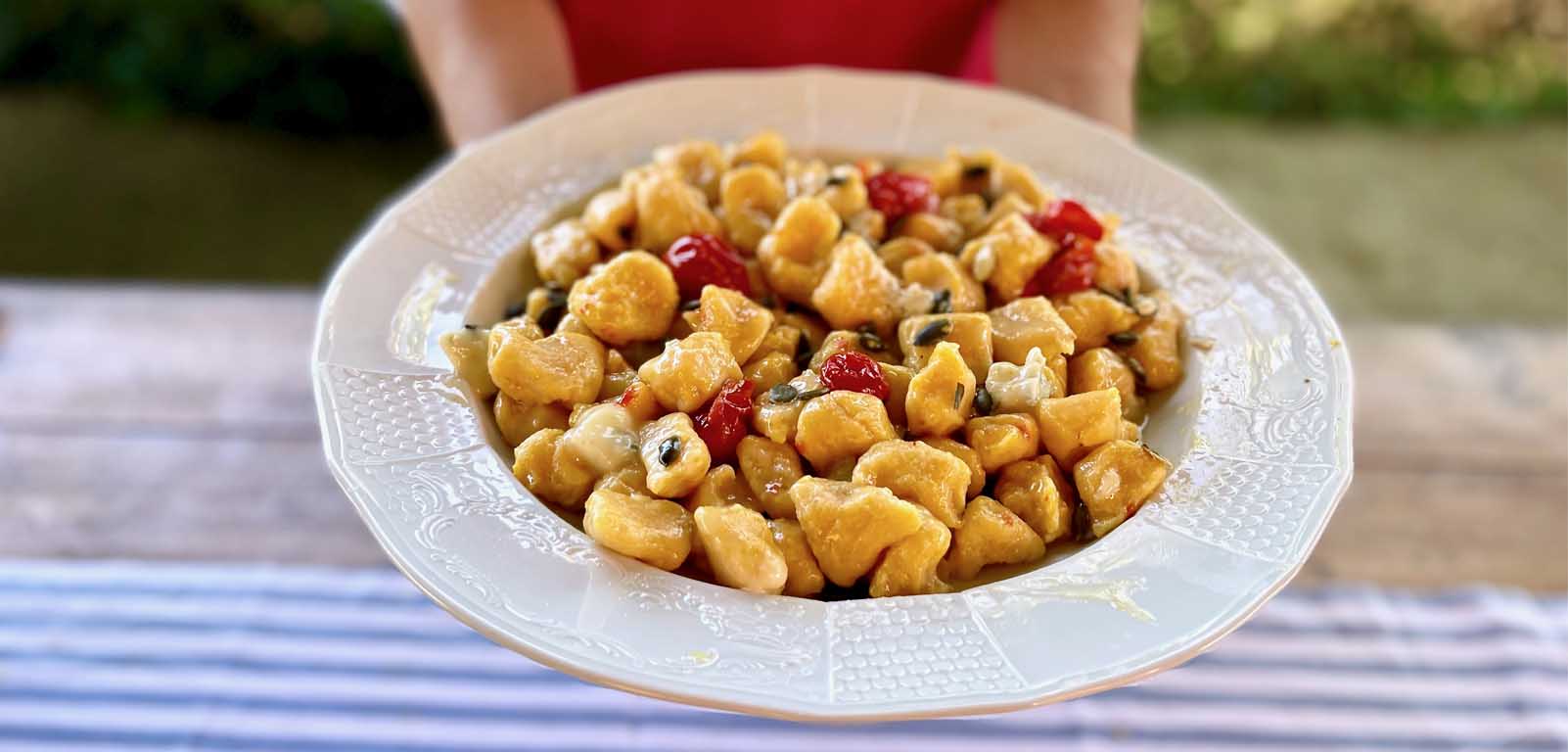
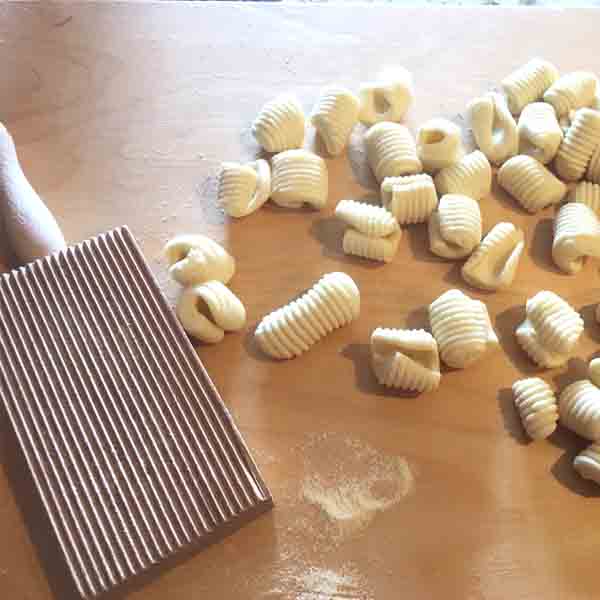

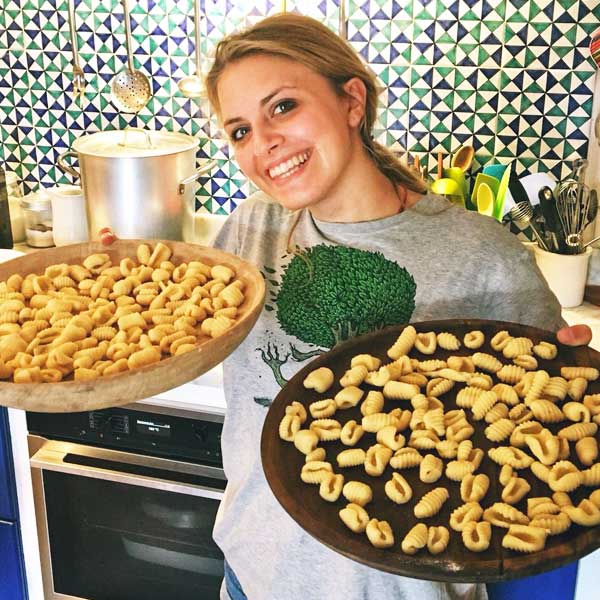
What is the best flour for making gnocchi?
I always suggest using 00 double zero flour. For most Italian dishes, this soft-wheat flour creates a delicate texture that’s easy to bite through.
Double zero is perfect for the light, pillowy texture you want for gnocchi. All-purpose or bread flours are not the best flours to make gnocchi because they add too much chew and density.
If you use a lighter flour like cake flour, the gnocchi dough will also have a harder time coming together. 00 flour seems to work best.
Stock up on double zero flour from Antimo Caputo ▶︎
Can you make gnocchi without potatoes?
The short answer is, yes! We’ve mentioned that a traditional method is to use flour as a base.
If you’re up for experimenting, I also suggest trying to make gnocchi using butternut squash or semolina gnocchi.
Don’t forget, gnocchi is all about the shape and so another recipe to consider is the classic spinach and ricotta Gnudi.
MORE GNOCCHI FAQs
Can you make gluten free gnocchi?
The traditional gnocchi recipe call for the use of flour with gluten as a binder. Even potato gnocchi is not typically gluten-free.
But that doesn’t mean you can’t make gluten free gnocchi. With the abundance of alternative, gluten free flours (especially the blends used to substitute for all-purpose flour), there are a variety of options to make gluten-free gnocchi pasta.
If you make potato or squash-based gnocchi doughs, it’s even easier to substitute with a gluten-free flour. We’ve personally experimented using rice flour and potato flakes as a way to help bring the dough together.
Can you reheat gnocchi?
Of course it’s possible to reheat gnocchi, although gnocchi is really best when it’s eaten fresh. How to reheat gnocchi is similar to how you might reheat any other leftovers. Pre-cooked, refrigerated gnocchi and sauce leftovers can be gently reheated in a sauté pan or a microwave.
How long does gnocchi last?
Uncooked, frozen gnocchi can last for months!
When to eat gnocchi
In a traditional Italian meal, gnocchi are usually served after the starter as a first course, known as the Primi (pasta course).
Followed by a second course, a side dish and a dessert, gnocchi was a delicious pasta course during the good all days when families had a complete meal almost everyday. Now, this happens only on special occasions.
Usually gnocchi appeared on the table on Thursday and in my family, as in many other Italian families, we say: giovedì gnocchi!
This ritual of having gnocchi on Thursday was due to the necessity of eating a rich and satisfying dish in anticipation of Friday, when people used to abstain from eating meat with a lighter fish-based meal, according to the Catholic tradition. Even now, my mom doesn’t eat meat on Friday.
How do I store gnocchi?
Gnocchi stored in the fridge uncooked is best used within 2-3 days. Cooked gnocchi in sauce can last a couple of days covered in a fridge for leftovers.
See more about gnocchi storage in the section above.
What to eat with gnocchi
In restaurants, gnocchi is also paired with seafood. Often on a menu you can find gnocchi with clams, shrimp or squid. That’s how versatile gnocchi pasta is.
That being said, gnocchi can be a meal unto itself as, considering they have potatoes, egg and flours, it’s a very substantial dish.
When served as a main course, there are infinite gnocchi side dish recipes. I base side dishes for gnocchi on vegetables, to balance the richness of the gnocchi dish.
When thinking about what to serve with gnocchi, try with different salads, beans, mushrooms, other cooked vegetablessuch as asparagus or brussel sprouts… anything that can enhance the sauce and the flavor of your small dumplings.
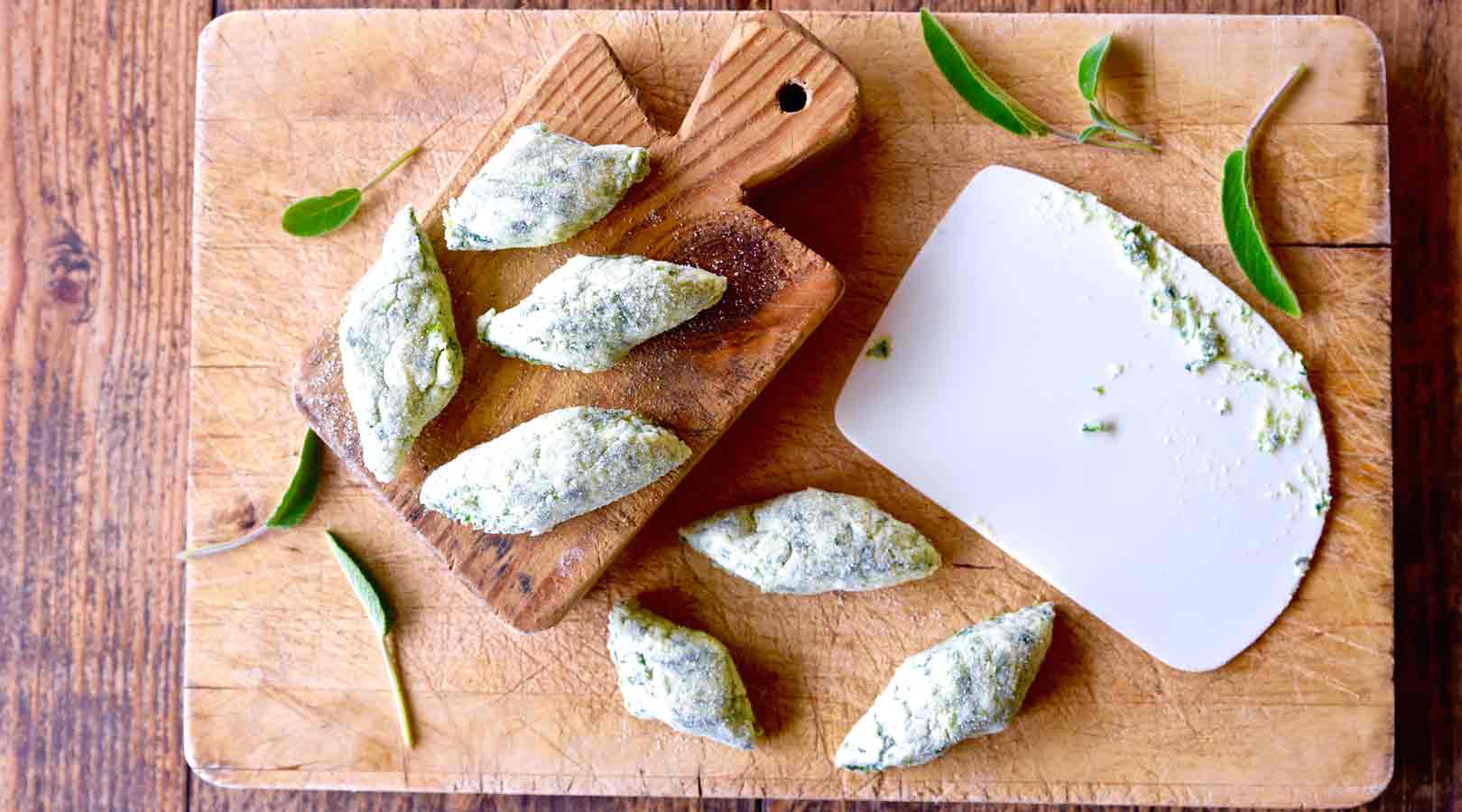
Gnocchi vs. Gnudi: What is the difference?
The gnudi, or spinach and ricotta gnocchi, belongs to the big family of gnocchi and it’s a typical recipe from Tuscany of peasant’s origin.
Instead of using potatoes, the gnudi dough is made with creamy ricotta cheese and steamed spinach, with the addition of flour and eggs to hold the gnocchi together. The big difference between the two dumplings is in the ingredients used to make the dough.
Gnudi: ricotta cheese, spinach, eggs, flour
Potato Gnocchi: mashed potatoes, flour, eggs
The name gnudi comes from the Italian word ‘nudi’ that means naked and it refers to the idea that this gnocchi is a naked ravioli – just the filling without the pasta shell.
Compared to potato gnocchi, gnudi is a more delicate type of gnocchi, with a lighter texture and an oval shape.
Even if you’re not a gnocchi master, gnudi is easy to make and doesn’t require any particular manual skill or tools. The only attention must be paid to the moisture in the ricotta and the steamed spinach: both have to be very well drained.
Gnudi can also be a gluten-free gnocchi, if using a gluten free flour instead of wheat flour.
